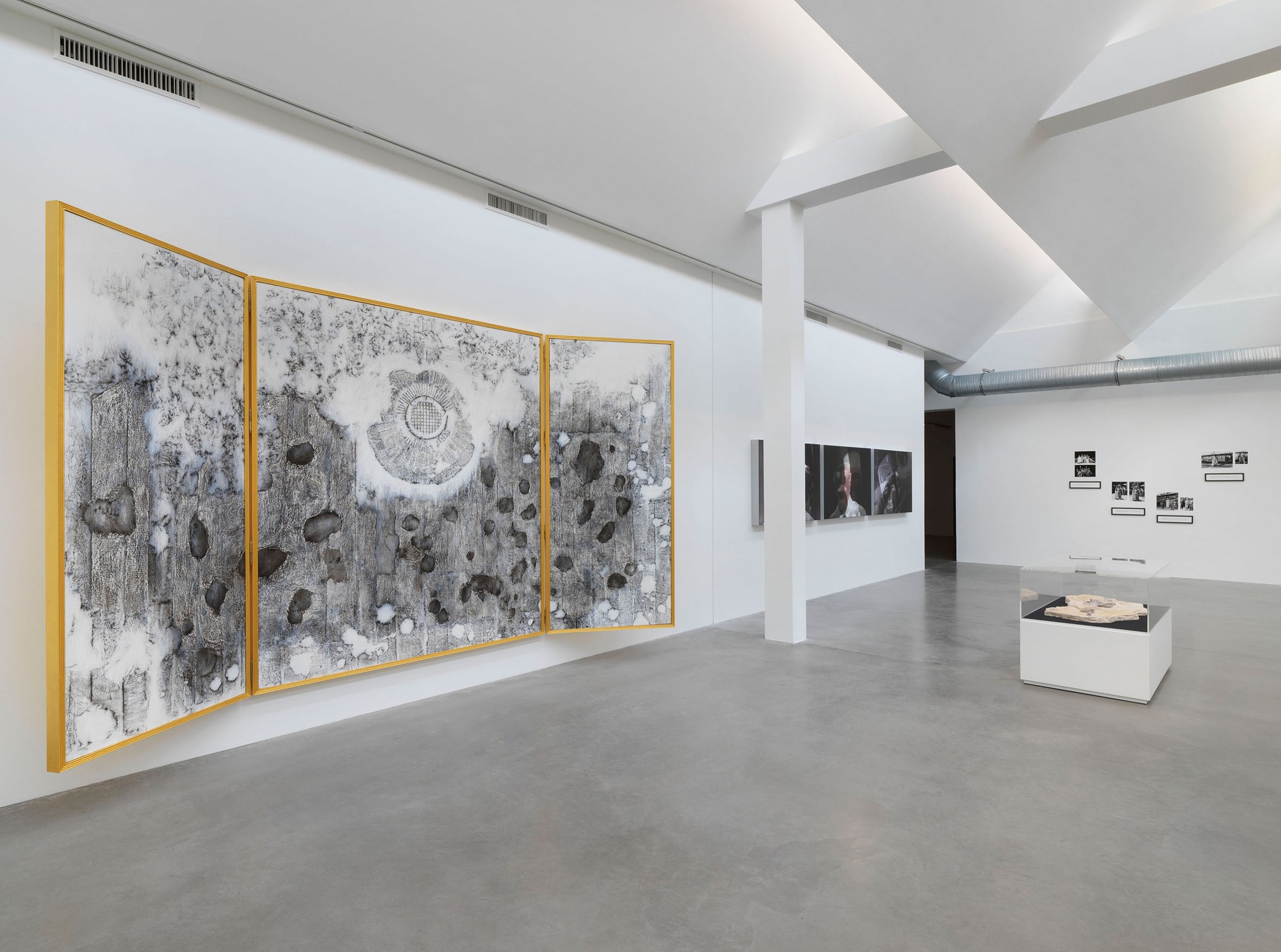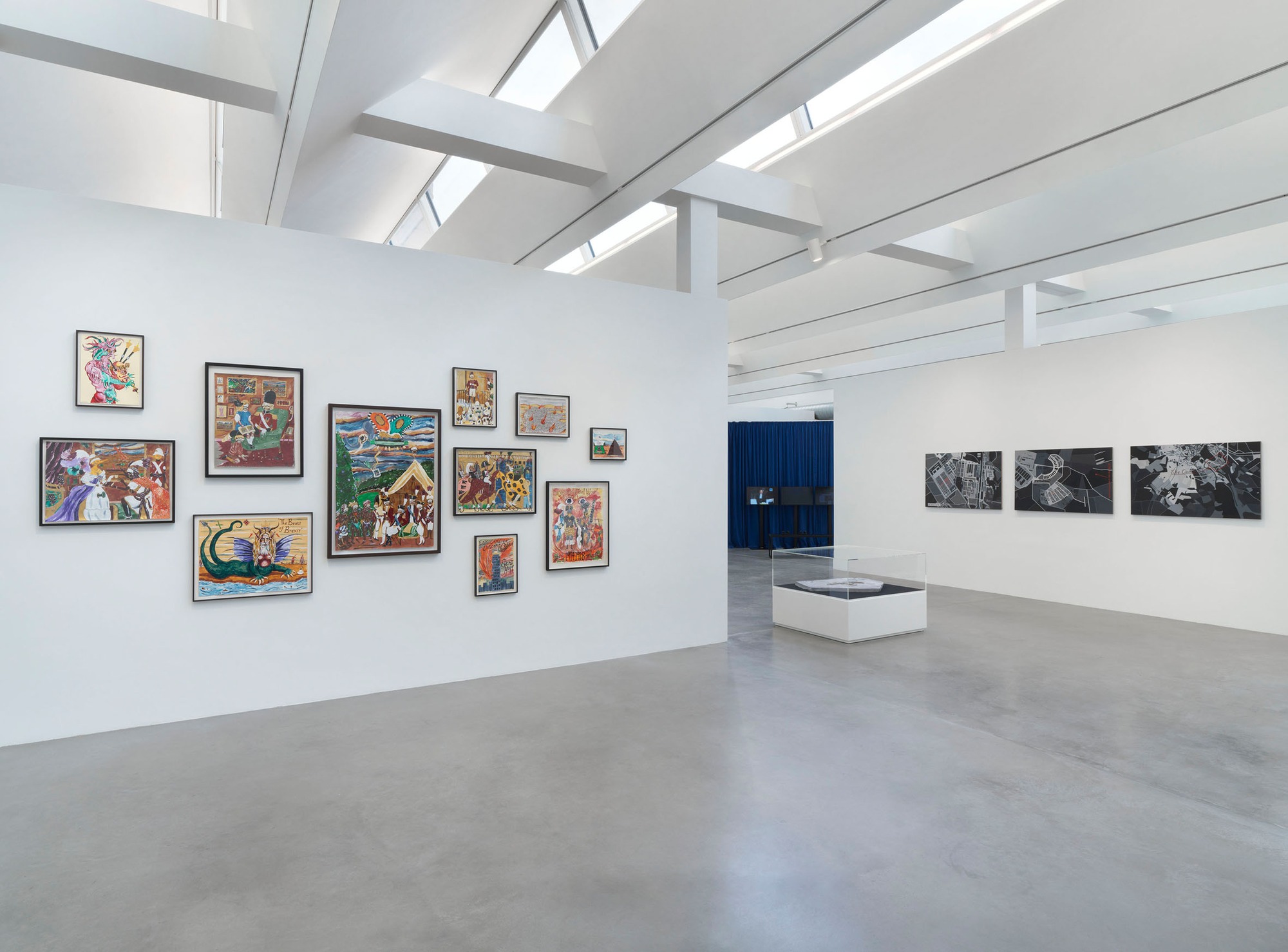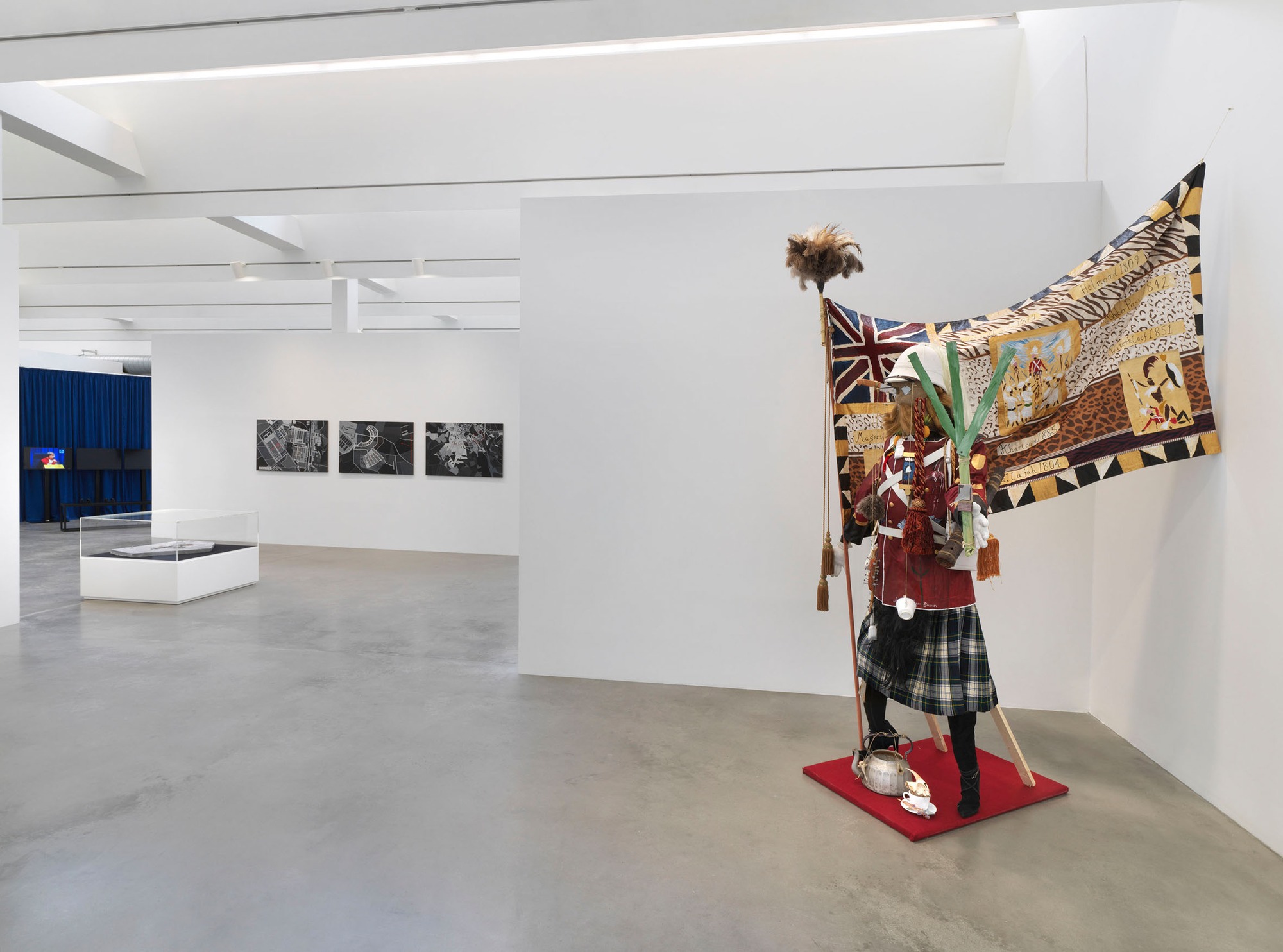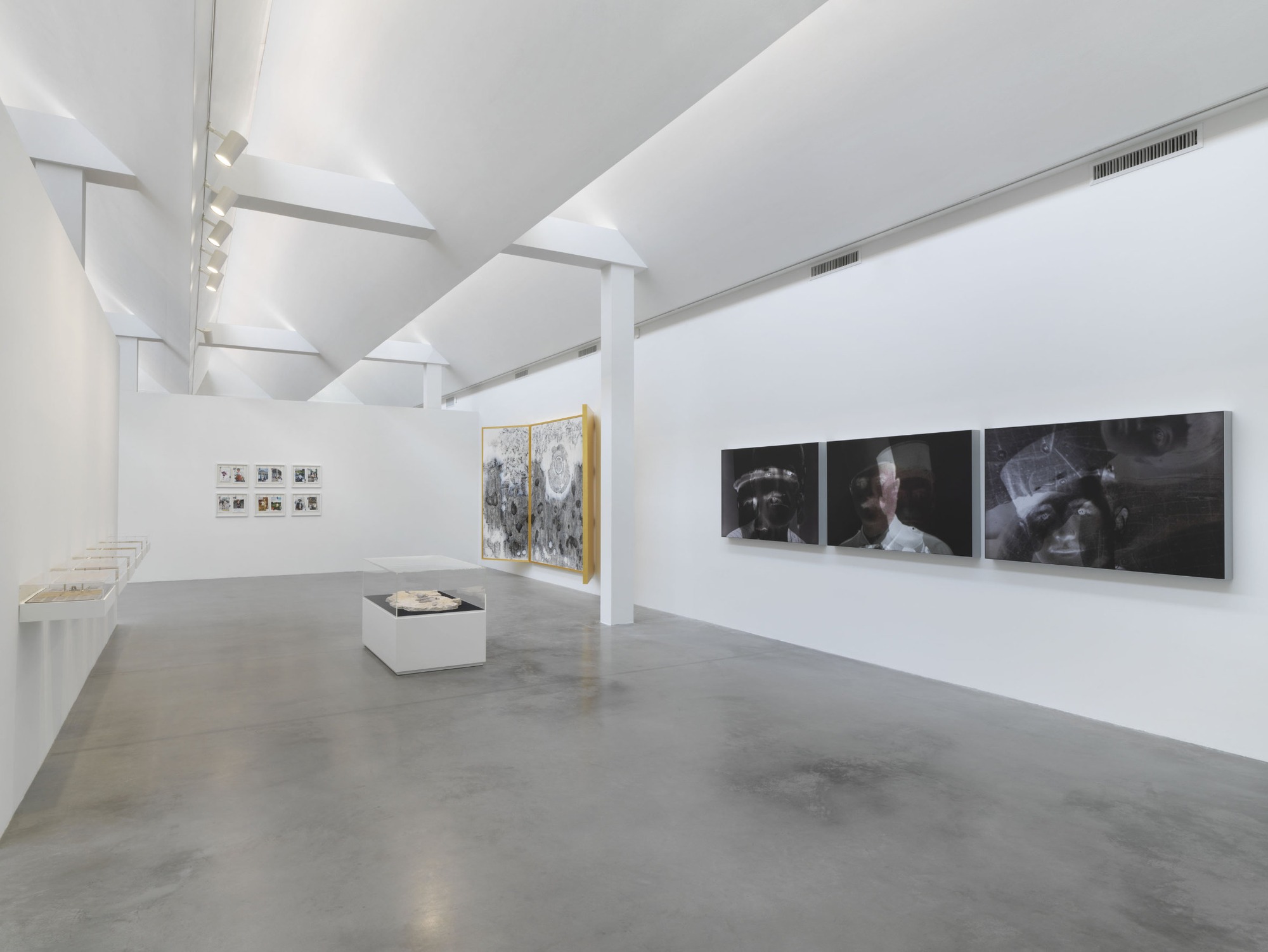The Invented History
13 Sep 2020 - 21 Feb 2021

The Invented History, Installation view, Maschinenhaus M2, KINDL – Centre for Contemporary Art, Berlin, Photo: Jens Ziehe, 2020
from left to right
Nadia Kaabi-Linke, The Altarpiece, 2015;
Yael Bartana, R.I.P. M16, 2019;
Akram Zaatari, Faces to Faces, 2015;
Maryam Jafri, Getty Vs. Ghana, 2012
from left to right
Nadia Kaabi-Linke, The Altarpiece, 2015;
Yael Bartana, R.I.P. M16, 2019;
Akram Zaatari, Faces to Faces, 2015;
Maryam Jafri, Getty Vs. Ghana, 2012

The Invented History, Installation view, Maschinenhaus M2, KINDL – Centre for Contemporary Art, Berlin, Photo: Jens Ziehe, 2020
from left to right
Andrew Gilbert, various works;
Anna Dasović, Concerning: Request for erased and ‘blurry’ photographs, 2015 – 2017 (Detail);
Yael Bartana, R.I.P. UZI, 2019;
Ramesch Daha, Unlimited History – Sigmund Klein, 2017 – 2020 (Detail)
from left to right
Andrew Gilbert, various works;
Anna Dasović, Concerning: Request for erased and ‘blurry’ photographs, 2015 – 2017 (Detail);
Yael Bartana, R.I.P. UZI, 2019;
Ramesch Daha, Unlimited History – Sigmund Klein, 2017 – 2020 (Detail)

The Invented History, Installation view, Maschinenhaus M2, KINDL – Centre for Contemporary Art, Berlin, Photo: Jens Ziehe, 2020
from left to right
Anna Dasović, Concerning: Request for erased and ‘blurry’ photographs, 2015 – 2017 (Detail);
Yael Bartana, R.I.P. UZI, 2019;
Ramesch Daha, Unlimited History – Sigmund Klein, 2017 – 2020 (Detail);
Andrew Gilbert, Monument to Major General Andrew Gilbert calling a Drone Strike on his Leek Phone at the Battle of Magersfontein, 11th December, 1899, South Africa, 2020.
from left to right
Anna Dasović, Concerning: Request for erased and ‘blurry’ photographs, 2015 – 2017 (Detail);
Yael Bartana, R.I.P. UZI, 2019;
Ramesch Daha, Unlimited History – Sigmund Klein, 2017 – 2020 (Detail);
Andrew Gilbert, Monument to Major General Andrew Gilbert calling a Drone Strike on his Leek Phone at the Battle of Magersfontein, 11th December, 1899, South Africa, 2020.

The Invented History, Installation view, Maschinenhaus M2, KINDL – Centre for Contemporary Art, Berlin, Photo: Jens Ziehe, 2020
from left to right
Zartosht Rahimi, New Imaginary Map, 2020;
Andrew Gilbert, Monument to Major General Andrew Gilbert calling a Drone Strike on his Leek Phone at the Battle of Magersfontein, 11th December, 1899, South Africa, 2020;
Jean-Ulrick Désert, Negerhosen2000 / The Travel Album, 2003 / 2007;
Yael Bartana, R.I.P. M16, 2019.
from left to right
Zartosht Rahimi, New Imaginary Map, 2020;
Andrew Gilbert, Monument to Major General Andrew Gilbert calling a Drone Strike on his Leek Phone at the Battle of Magersfontein, 11th December, 1899, South Africa, 2020;
Jean-Ulrick Désert, Negerhosen2000 / The Travel Album, 2003 / 2007;
Yael Bartana, R.I.P. M16, 2019.

The Invented History, Installation view, Maschinenhaus M2, KINDL – Centre for Contemporary Art, Berlin, Photo: Jens Ziehe, 2020
from left to right
Akram Zaatari, Iraqi Ruins, 2017;
Jean-Ulrick Désert, Negerhosen2000 / The Travel Album, 2003 / 2007;
Yael Bartana, R.I.P. M16, 2019;
Nadia Kaabi-Linke, The Altarpiece, 2015;
Akram Zaatari, Faces to Faces, 2017.
from left to right
Akram Zaatari, Iraqi Ruins, 2017;
Jean-Ulrick Désert, Negerhosen2000 / The Travel Album, 2003 / 2007;
Yael Bartana, R.I.P. M16, 2019;
Nadia Kaabi-Linke, The Altarpiece, 2015;
Akram Zaatari, Faces to Faces, 2017.
Artists: Yael Bartana, Ramesch Daha, Anna Dasović, Jean-Ulrick Désert, Andrew Gilbert, Aslan Ġoisum, Maryam Jafri, Nadia Kaabi-Linke, Zartosht Rahimi, Larissa Sansour / Søren Lind, Maja Weyermann, Akram Zaatari
The group exhibition The Invented History examines the need to critically question historical narratives. At the latest with the influence of globalisation, a re-evaluation of historiography has become necessary: it is no longer viewed as a simple collection of data and facts, a linear sequence of clearly defined events. Instead, there is a growing awareness that historiography must always also be interpreted under the political auspices of its “authors”. Today there are increasing attempts to control the interpretation of history—first and foremost by anti-democratic forces around the world. The artists in the exhibition track down previously concealed or suppressed historical phenomena, view history through the filter of their own biography, and thus work on a critical historiography in contrast to existing systems of rule.
Artistic research is an important method for the artists in the exhibition. Anna Dasović’s work Request for erased and ‘blurry’ photographs (2015–17) traces the political entanglements of two rolls of film that were used by members of the Dutch UN battalion during the genocide in Srebrenica in the summer of 1995. Bosnian-Serb militias penetrated the UN safe area and murdered more than 8,000 Muslim men and boys in front of Dutch UN Blue Helmets. Only three “blurry photographs” exist from these two rolls of film, which were made public in the Netherlands only after the artist’s intervention.
Maryam Jafri also poses questions about copyright, digitisation, and foreign ownership of national heritage. On the website of the photo agency Getty Images, the artist discovered photographs from Ghana’s declaration of independence on 6 March 1957—the first documents of the liberation of Sub-Saharan Africa from Western domination—which are also held in the archives of Ghana’s Ministry of Information. In her installation Getty vs. Ghana (2012) she compares the images and reveals incorrect dates, keywords, and captions as well as obvious manipulations of the original files.
In her research on a film about Anatolian carpets and their significance for the region’s cultural memory, Maja Weyermann discovered the key role that Armenian carpet knotting played in production in Turkey before 1915, in the time before the systematic genocide against the Armenians. Processes of remembering and (politically intentional) forgetting are also the subject of Aslan Ġoisum’s film People of No Consequence (2016), which likewise deals with the recovery of knowledge about historical processes—in this case, the oppression and deportation of the local population from what is now the Russian republic of Chechnya, which began under the Soviet power.
Other artists in the exhibition turn to utopian futures and thus question our understanding of historiography. Yael Bartana’s petrified weapons R.i.P. Uzi, R.i.P. M16, and R.i.P. Smith & W (all 2019) are a vision of a distant time when weapons only exist as fossils from an antiquated stage of civilisation. The video In the Future They Ate from the Finest Porcelain (2015) by Larissa Sansour and Søren Lind also shows history as a complex network: a fictional resistance fighter buries porcelain objects as supposed traces of a past civilisation with the aim of creating a new historiography in which facts and fictions merge to form a new narrative.
The exhibition is curated by Kathrin Becker.
The group exhibition The Invented History examines the need to critically question historical narratives. At the latest with the influence of globalisation, a re-evaluation of historiography has become necessary: it is no longer viewed as a simple collection of data and facts, a linear sequence of clearly defined events. Instead, there is a growing awareness that historiography must always also be interpreted under the political auspices of its “authors”. Today there are increasing attempts to control the interpretation of history—first and foremost by anti-democratic forces around the world. The artists in the exhibition track down previously concealed or suppressed historical phenomena, view history through the filter of their own biography, and thus work on a critical historiography in contrast to existing systems of rule.
Artistic research is an important method for the artists in the exhibition. Anna Dasović’s work Request for erased and ‘blurry’ photographs (2015–17) traces the political entanglements of two rolls of film that were used by members of the Dutch UN battalion during the genocide in Srebrenica in the summer of 1995. Bosnian-Serb militias penetrated the UN safe area and murdered more than 8,000 Muslim men and boys in front of Dutch UN Blue Helmets. Only three “blurry photographs” exist from these two rolls of film, which were made public in the Netherlands only after the artist’s intervention.
Maryam Jafri also poses questions about copyright, digitisation, and foreign ownership of national heritage. On the website of the photo agency Getty Images, the artist discovered photographs from Ghana’s declaration of independence on 6 March 1957—the first documents of the liberation of Sub-Saharan Africa from Western domination—which are also held in the archives of Ghana’s Ministry of Information. In her installation Getty vs. Ghana (2012) she compares the images and reveals incorrect dates, keywords, and captions as well as obvious manipulations of the original files.
In her research on a film about Anatolian carpets and their significance for the region’s cultural memory, Maja Weyermann discovered the key role that Armenian carpet knotting played in production in Turkey before 1915, in the time before the systematic genocide against the Armenians. Processes of remembering and (politically intentional) forgetting are also the subject of Aslan Ġoisum’s film People of No Consequence (2016), which likewise deals with the recovery of knowledge about historical processes—in this case, the oppression and deportation of the local population from what is now the Russian republic of Chechnya, which began under the Soviet power.
Other artists in the exhibition turn to utopian futures and thus question our understanding of historiography. Yael Bartana’s petrified weapons R.i.P. Uzi, R.i.P. M16, and R.i.P. Smith & W (all 2019) are a vision of a distant time when weapons only exist as fossils from an antiquated stage of civilisation. The video In the Future They Ate from the Finest Porcelain (2015) by Larissa Sansour and Søren Lind also shows history as a complex network: a fictional resistance fighter buries porcelain objects as supposed traces of a past civilisation with the aim of creating a new historiography in which facts and fictions merge to form a new narrative.
The exhibition is curated by Kathrin Becker.
